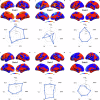Reconfiguration of brain network dynamics in bipolar disorder: a hidden Markov model approach
- PMID: 39737898
- PMCID: PMC11685458
- DOI: 10.1038/s41398-024-03212-3
Reconfiguration of brain network dynamics in bipolar disorder: a hidden Markov model approach
Abstract
Bipolar disorder (BD) is a neuropsychiatric disorder characterized by severe disturbance and fluctuation in mood. Dynamic functional connectivity (dFC) has the potential to more accurately capture the evolving processes of emotion and cognition in BD. Nevertheless, prior investigations of dFC typically centered on larger time scales, limiting the sensitivity to transient changes. This study employed hidden Markov model (HMM) analysis to delve deeper into the moment-to-moment temporal patterns of brain activity in BD. We utilized resting-state functional magnetic resonance imaging (rs-fMRI) data from 43 BD patients and 51 controls to evaluate the altered dynamic spatiotemporal architecture of the whole-brain network and identify unique activation patterns in BD. Additionally, we investigated the relationship between altered brain dynamics and structural disruption through the ridge regression (RR) algorithm. The results demonstrated that BD spent less time in a hyperconnected state with higher network efficiency and lower segregation. Conversely, BD spent more time in anticorrelated states featuring overall negative correlations, particularly among pairs of default mode network (DMN) and sensorimotor network (SMN), DMN and insular-opercular ventral attention networks (ION), subcortical network (SCN) and SMN, as well as SCN and ION. Interestingly, the hypoactivation of the cognitive control network in BD may be associated with the structural disruption primarily situated in the frontal and parietal lobes. This study investigated the dynamic mechanisms of brain network dysfunction in BD and offered fresh perspectives for exploring the physiological foundation of altered brain dynamics.
© 2024. The Author(s).
Conflict of interest statement
Competing interests: The authors declare no competing interests. Ethics approval and consent to participate: The neuroimaging dataset used in this study was approved by the Institutional Review Boards at UCLA and the Los Angeles County Department of Mental Health. All participants provided written informed consent.
Figures






Similar articles
-
Disrupted default mode network connectivity in bipolar disorder: a resting-state fMRI study.BMC Psychiatry. 2024 Jun 7;24(1):428. doi: 10.1186/s12888-024-05869-y. BMC Psychiatry. 2024. PMID: 38849793 Free PMC article.
-
Aberrant resting-state functional network centrality and cognitive impairment in unmedicated, euthymic bipolar patients.BMC Psychiatry. 2024 Dec 31;24(1):963. doi: 10.1186/s12888-024-06427-2. BMC Psychiatry. 2024. PMID: 39741246 Free PMC article.
-
Shared and distinct patterns of default mode network dysfunction in major depressive disorder and bipolar disorder: A comparative meta-analysis.J Affect Disord. 2025 Jan 1;368:23-32. doi: 10.1016/j.jad.2024.09.021. Epub 2024 Sep 10. J Affect Disord. 2025. PMID: 39260575
-
Default mode network activity in bipolar disorder.Epidemiol Psychiatr Sci. 2020 Sep 8;29:e166. doi: 10.1017/S2045796020000803. Epidemiol Psychiatr Sci. 2020. PMID: 32895076 Free PMC article. Review.
-
Brain networks: foundations and futures in bipolar disorder.J Ment Health. 2010 Apr;19(2):157-67. doi: 10.3109/09638230903469129. J Ment Health. 2010. PMID: 20433323 Review.
Cited by
-
Sex effects on dynamic structure-function coupling of intrinsic brain network.Brain Imaging Behav. 2025 Jun 26. doi: 10.1007/s11682-025-01036-3. Online ahead of print. Brain Imaging Behav. 2025. PMID: 40571838
-
Transition and dynamic reconfiguration in late-life depression based on hidden Markov model.Npj Ment Health Res. 2025 May 27;4(1):22. doi: 10.1038/s44184-025-00137-7. Npj Ment Health Res. 2025. PMID: 40419788 Free PMC article.
-
Depression links to unstable resting-state brain dynamics: insights from hidden markov models and functional network variability.Psychol Med. 2025 Jul 17;55:e200. doi: 10.1017/S0033291725101001. Psychol Med. 2025. PMID: 40671332 Free PMC article.
References
MeSH terms
Grants and funding
LinkOut - more resources
Full Text Sources
Medical

